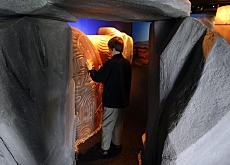
Closure of Mystery Park is no enigma

The demise of the Mystery Park in the Bernese Oberland resort of Interlaken, which closed on Sunday, is no enigma but the result of bad decisions, experts say.
They argue that the main reasons for the closure are the static nature of the exhibition, the slow involvement of local tourism and the stock exchange decline between 2001 and 2003.
“Mystery Park needs extraterrestrial saviour” and “Career dreamer Erich von Däniken pulls back” were just two of the sarcastic headlines journalists made in a long series of negative reports.
The criticism stepped up in 2005 and was particularly heavy in the spring of 2006 when the park had to ask for a delay in bankruptcy proceedings and protection from its creditors.
It all began in 1997 with ambitious plans. Best-selling Swiss author Erich von Däniken announced he wanted to open a theme park devoted to unsolved (extra-)terrestrial mysteries on the site of the former local military airport.
As an international personality and mystery expert whose books have been translated into numerous languages, von Däniken appeared to be a guarantee that the park would be managed professionally.
UFO image
But Hannes Imboden, the former Bernese Oberland tourism director, said the communications department of the Mystery Park did not correct the one-sided UFO image that most people have of von Däniken.
A similar assessment comes from the current director, Fritz Zemp, who has been at the mystery park since April 2005.
“The marketing segment to target was not systematically approached at the outset,” Zemp said. “What was more important – entertainment, focusing on the UFO element of the hard core of von Däniken followers, or learning and education aspects?”
After critical financial questions, the park opened its doors in May 2003. As the banks declined to provide money, the finances came from a group of private investors and the public who bought shares at a low par value despite the troubles at the stock exchange.
“Von Däniken was unable to put into place what he’d really wanted,” Thomas Vaszary, a lecturer at Lucerne’s tourism college, told swissinfo.
“It seemed a bad realisation of von Däniken’s ideas. It lacked life and interaction.”
At the beginning Imboden had advised that at least a third of the park’s exhibition should be changeable, a strategy that might have encouraged people to make return visits.
Lack of life
Zemp also felt there was a lack of life in the park. “Technically it would have been easy to change the software and hardware to counter the statics of the exhibition,” he said.
Christian Laesser, deputy director of the St Gallen Institute for Tourism, criticised a lack of innovation after the park had been built.
He said that successful parks were those that continuously developed – like, for example, the Europa-Park in Rust, Germany. “Only that [kind of development] maintains a steady flow of visitors,” he told swissinfo.
Zemp said there were many professional providers of tourist services in the Bernese Oberland – the Jungfrau Railways, many hotels, adventure firms and tour operators – that would have been possible partners for the park.
He said the Mystery Park had only begun very late to offer packages that included meals and overnight stays.
The park’s financing ran into difficulties and was not helped by falls at the stock market. There were also groups of small and large shareholders that had different interests, according to Zemp.
The fate of the Mystery Park now lies with the liquidator, who Zemp feels will probably put forward a number of proposals at next month’s meeting of creditors.
Insolvency proceedings are due to end on January 10. If none of the suggestions is accepted by the creditors, the park will be auctioned.
swissinfo, Alexander Künzle
The business plan foresaw a half a million visitors a year at the beginning.
In its best year, 2004, the Mystery Park received 444,000 visitors.
At the end of November 2005, the figure had gone down to just over 200,000.
At the end of October 2006, the park welcomed its one millionth visitor.
February: An investor promises SFr27 million ($21.6 million). Two weeks later hopes are dashed when his middleman is arrested for suspected fraud.
March: Convertible bond holders approve the conversion of their bonds into capital stock. But there is still a hole of SFr4 million.
August: Businessman Jakob Dietiker says he is willing to pay SFr16 million for the park and to keep it open.
September: Dietiker suddenly changes his mind.
Interlaken and the largest single shareholder, the GBU company of Oskar Schärz, turn down a restructuring plan put forward by Franz Gyger.
May 21, 1997: Erich von Däniken announces his plans for the Mystery Park.
July 4, 2002: An investors group “Special Situation” approves SFr43 million for the park.
May 24, 2003: The park is opened and later receives a Milestone tourism prize and a Golden Idea Oscar.
May 2004: The break-even point is reached.
Summer 2005: Heavy floods in August lead to fewer visitors and a reduction of staff.
April/May2006: Protection from creditors.
September 2006: A company restructuring fails.
December 2006: A creditors’ meeting is scheduled.

In compliance with the JTI standards
More: SWI swissinfo.ch certified by the Journalism Trust Initiative

















![The four-metre-long painting "Sonntag der Bergbauern" [Sunday of the Mountain Farmers, 1923-24/26] had to be removed by a crane from the German Chancellery in Berlin for the exhibition in Bern.](https://www.swissinfo.ch/content/wp-content/uploads/sites/13/2025/12/01_Pressebild_KirchnerxKirchner.jpg?ver=8f77363a)











You can find an overview of ongoing debates with our journalists here . Please join us!
If you want to start a conversation about a topic raised in this article or want to report factual errors, email us at english@swissinfo.ch.